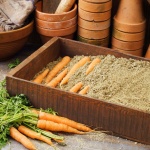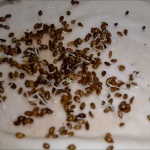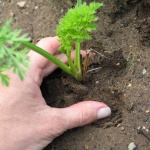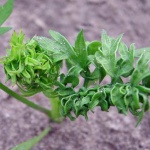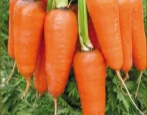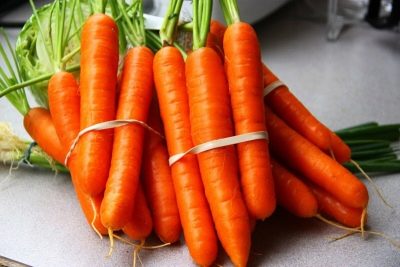
- Year of approval: 2009
- Appointment: for fresh consumption, for bundled products
- Leaf rosette shape: semi-spreading
- Leaves: medium length, green, medium to coarsely dissected
- Weight, g: 95-140
- The form : cylindrical with blunt tip
- Taste qualities: excellent
- Composition : dry matter 9.6-18.4%, total sugar 5.4-8.2%, carotene up to 17.8 mg per 100 g of raw matter
- Ripening terms: early
- Growing regions: Central
When planting carrots in the garden, you dream of sweet root vegetables that will be stored all winter. To get a plentiful and tasty harvest, it is enough to choose the optimal variety that quickly adapts to growing conditions. For the Central region, the early maturing variety Tushon, created by Russian scientists, would be an ideal option.
Breeding history
The early Tushon carrot is a vegetable crop bred by breeders of the Poisk agrofirm in 2006. The vegetable was added to the State Register of Breeding Achievements of the Russian Federation after three years of variety trials - in 2009. Carrots are cultivated in the Central Region. Today, the vegetable is massively grown in Ukraine and Moldova. You can plant a crop both in garden ridges and in the fields.
Description of the variety
Touchon is a plant with a developed aerial part, which has a powerful semi-spreading rosette and long-stemmed leaves. The foliage is characterized by a rich green color, moderate aroma and coarsely cut edges. Sometimes lighter tops with slightly dissected foliage are found. The root crop belongs to the Amsterdam cultivar.
It is worth noting resistance to flowering (shooting), and also the variety is not susceptible to cracking, even with prolonged storage. In addition, it is ideal for bunch growing.
Characteristics of the appearance of the plant and root crops
This carrot variety belongs to the medium-fruit class. Roots ripen aligned, almost the same, so it is ideal for growing for commercial purposes. The average weight of a specimen is 95-140 grams, and according to farmers, carrots grow even larger - 150-170 grams. The shape of vegetables is cylindrical with a rounded end. The length of each specimen reaches 18-20 cm. Ripe carrots are colored bright orange. The skin of the root vegetable is very thin, smooth, without visible flaws. On the surface, there are barely noticeable shallow eyes and light filamentous roots.
Selected vegetables can be transported without worrying about losses, as well as stored for a long time, since the keeping quality of the variety is high. Vegetables are best stored in dry, cool and dark places. It is not recommended to transport the earliest root vegetables that are not fully ripe, as they are fragile and brittle.
Purpose and taste of tubers
The root vegetables have excellent taste. The bright orange flesh has a tender, crispy, fleshy and very juicy texture without wateriness. The taste is dominated by sweetness and light sugariness, combined with a delicious, carrot aroma. The core is very thin and bright, so it does not differ much from the pulp. It is also worth noting that the core is not rigid.
For carrots, a universal purpose is characteristic - the vegetable is eaten fresh, pickled, added to hot and cold dishes, used for canning vegetables, frozen, and also grown for harvesting for the winter. In addition, carrots are ideal for juicing and pureing baby food.
Maturation
Touchon is an early ripening variety. From the mass emergence of seedlings to ripe root crops, it takes about 3 months - 70-90 days. The first copies can be used for cooking in mid-July, and the mass harvest is in August.
Yield
The variety is declared as high-yielding.On average, up to 5-6 kg of juicy root crops can be dug from 1 m2. On an industrial scale, the average yield is also pleasing, if you follow agricultural techniques - 296-416 centners / ha.
Growing and caring
A vegetable crop is planted through sowing seeds. For this, a section is carefully prepared in advance, where long grooves are made up to 3 centimeters deep. The distance between the rows should be 15-18 cm. Sowing is carried out according to the scheme 5-7 by 15-18 cm. Germination occurs after 2-3 weeks. Spring planting is carried out in late April - early May, when the temperature is stable + 6 ... 8 degrees. It is recommended to plant a vegetable in the place where onions, tomatoes or cucumbers used to grow.
This variety can be planted in summer (throughout June) to harvest until mid-autumn. In addition, carrots are sown before winter (late October - mid November).
Carrot care includes a chain of standard measures: loosening and weeding, weekly watering, thinning (twice during the growing season), fertilizing 2 times per season (it is preferable to fertilize with potash and phosphorus mixtures), prevention of viruses and insect infestations.
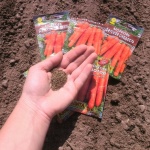
Carrots are one of the most unpretentious crops in terms of growing conditions; they can endure a short drought and a short cold snap. However, to get tasty and large root crops, you should adhere to the basic rules for planting carrots.


Soil requirements
Vegetable culture prefers light, loose loam and sandy loam with a deep arable layer. The soil should be moist, breathable, fertile, with neutral acidity. Carrots grow and develop poorly in heavy soils.
Required climatic conditions
The variety is stress-resistant, but prefers to grow in sunny areas, where there is a lot of light and heat. When planting, it should be borne in mind that the crop is susceptible to shade and drought. As a rule, carrots are planted in flat or slightly elevated areas, where there is no swampiness and stagnant moisture.
Disease and pest resistance
The variety has good immunity, so the culture rarely gets sick. The plant is exposed to diseases only with improper care or adverse weather conditions. The culture also does not attract pests. The only exception is the carrot fly.

Carrots grow in almost any garden. There is an opinion that this culture is very resistant to all kinds of diseases and pests, but this is not the case. Without proper care, carrots become susceptible to all kinds of infections and are affected by harmful insects.

